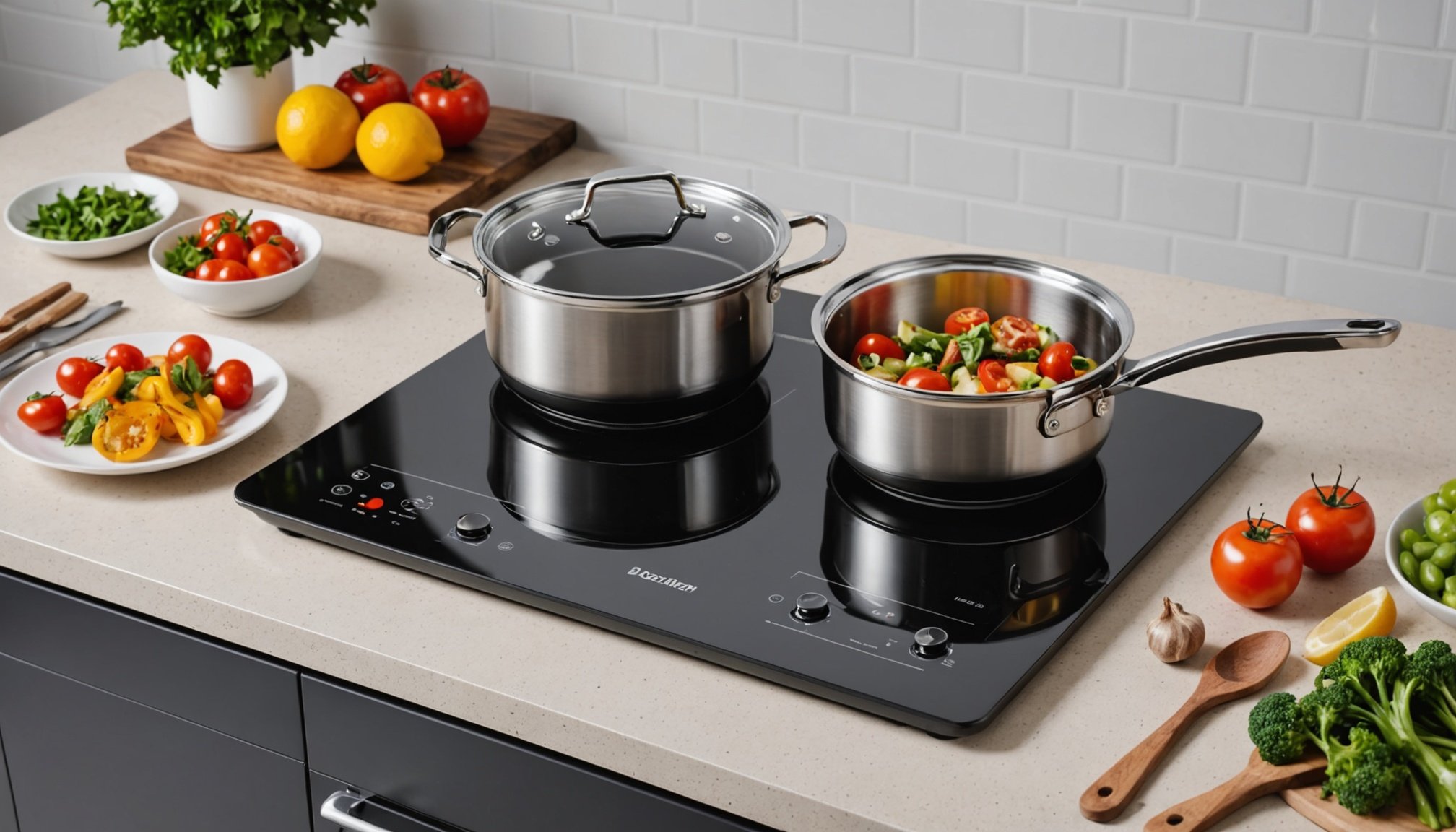Overview of Induction Cooktops
Induction cooktops have revolutionised modern cooking by offering efficiency and precision. Unlike traditional gas or electric stoves, induction cooktops use electromagnetic fields to directly heat pots and pans. This method allows for quicker heat transfer and energy efficiency. The cooktops themselves remain cool to the touch, adding to their safety features. This means cooking with induction cooktops not only saves time but also energy, making them a greener option.
In comparison to traditional cooking methods, induction cooktops provide superior temperature control. Gas stoves can pose a risk of uneven heat distribution, resulting in unpredictable cooking results. Electric stoves, while safer than gas, often take longer to heat up and cool down. Induction cooktops’ rapid response to temperature adjustments eliminates these issues, delivering more consistent cooking outcomes.
A découvrir également : Ultimate Guide to Perfecting Your Vlogging Lighting Setup in a UK Home Studio
The popularity of induction cooktops has surged, especially among urban dwellers. With limited kitchen space and a demand for efficiency, they value the sleek design and space-saving benefits of these appliances. Moreover, induction cooktops are increasingly present in modern homes, appealing to tech-savvy individuals seeking innovation in their daily cooking routines. Their advanced technology and aesthetics continue to attract a growing number of households.
Energy Efficiency
Induction cooktops are renowned for their energy efficiency. Unlike traditional gas or electric options, induction cooktops heat directly through electromagnetic fields, reducing heat loss significantly. This method ensures that energy is mainly used to cook food rather than heating the surrounding air, leading to quicker cooking times and cost savings on utility bills.
A lire en complément : Top Anti-Slip Flooring Solutions for Wet Areas in UK Homes: Safety and Style Combined
Induction cooking can save up to 10% more energy compared to electric coils and over 50% compared to gas. This is because induction cooktops only activate when compatible cookware is placed on the surface, ensuring minimal energy waste. For households, this energy efficiency translates into noticeable reductions in monthly utility bills.
Additionally, induction cooktops are incredibly eco-friendly. By minimising energy use, they reduce reliance on fossil fuels, which decreases carbon emissions. The precise control of cooking temperatures also reduces overcooking, ultimately cutting down on food waste. Choosing an induction cooktop aligns with modern sustainability goals, supporting eco-conscious living with practical technology.
In summary, using this technology in the kitchen not only optimises energy use but also contributes to environmental benefits, making it a smart choice both economically and ecologically.
Safety Features
When considering appliances with safety features, especially for families with children, it’s crucial to focus on designs that enhance child safety. For instance, devices with an auto shut-off mechanism significantly reduce the risk of accidents. This feature automatically turns off the appliance when not in use or when it overheats, ensuring cooking safety by preventing fires or burns.
A major advantage for homes, especially in urban settings where space can be limited, is the inclusion of cool-to-the-touch surfaces. These surfaces remain safe to touch even while the device is in operation, minimizing the risk of burns—a vital feature for families with curious young explorers around the house.
Child safety is greatly enhanced by these safety features, allowing parents to cook or carry out activities without constant worry. In compact living environments, the presence of intuitive and responsive safety mechanisms becomes even more crucial, offering peace of mind and encouraging families to utilize their spaces effectively.
Understanding and investing in appliances with robust safety features ensures not only a safer home environment but also contributes to an enjoyable cooking experience, free from unnecessary hazards.
Space-Saving Design
In increasingly popular compact kitchens typical of urban living, space-saving solutions are indispensable. Induction cooktops, with their minimalistic and sleek design, become ideal choices, especially suited for small kitchens.
The compact size of these cooktops allows them to fit comfortably into tight spaces without sacrificing functionality. In apartments where every inch counts, they provide an ingenious way to maximise kitchen efficiency. Their streamlined appearance complements open shelving and integrated storage solutions, enhancing the overall aesthetic without cluttering the environment.
Moreover, induction cooktops offer unparalleled flexibility in kitchen designs and configurations. Their portable nature means they can be easily installed or repositioned to suit various kitchen layouts. This flexibility not only caters to individual culinary needs but also supports the dynamic design elements often found in urban living.
For apartment dwellers, the induction cooktop is a boon. Its quick heating mechanism and ease of cleaning reduce time spent on chores, freeing up more room for living. The synergy between compact living spaces and induction technology embodies the modern ethos of efficiency and style, serving as a perfect fit for contemporary compact kitchens.
Ease of Cleaning
A standout feature of modern countertops is their user-friendly design, especially when it comes to cleaning and maintaining a kitchen that sparkles. Non-porous surfaces are a game-changer in kitchen maintenance. Unlike porous alternatives, these surfaces resist stains, meaning spills from tomato sauces or coffee can be wiped clean without leaving a mark. This makes them incredibly easy to clean and ideal for busy households that need quick solutions.
In terms of maintenance, non-porous surfaces also leave little room for bacteria to hide, contributing to a more hygienic environment. This is crucial for health-conscious individuals aiming to keep their cooking areas spotless with minimal effort.
Let’s consider the time-saving aspects offered by these surfaces. Compared to traditional kitchen tops like tile or wood, non-porous options eliminate the need for special cleaning agents or labour-intensive scrubbing. A simple damp cloth usually suffices to restore their shine, thereby saving precious time.
In contrast, other cooking surfaces, such as stainless steel or glass, may require specific cleaners to avoid streaks or damage. For homeowners valuing efficiency and practicality, non-porous counters deliver the easiest cleaning experience, maintaining a sleek, polished look with minimal fuss.
User Testimonials and Experiences
Engaging with user reviews offers a treasure trove of insights. In the UK apartment context, personal stories highlight the remarkable impact of products on everyday life. An apparent trend among users is the appreciation for devices that seamlessly integrate into their routines. For instance, a user shared how a device’s key features, such as automated scheduling and adaptable settings, turned an otherwise mundane task into a stress-free experience.
Amid the praise, some users noted issues, providing valuable lessons. For example, an individual encountered connectivity problems but uncovered a solution through a community forum, showcasing the power of shared experiences. Such testimonials reveal that even the most real-life experiences come with challenges. However, these hurdles often lead to innovative solutions and improvements over time.
Overall, these stories underscore the importance of understanding user feedback. While individual experiences vary, they collectively contribute to forming a clearer picture of a product’s long-term viability. Learning from both the triumphs and setbacks shared ensures informed decision-making, ultimately elevating the product experience for future users. By listening to real people who have tested these products, potential buyers can better align their choices with their specific needs and expectations.
Comparisons with Other Cooking Methods
When it comes to evaluating cooking methods, induction cooktops often emerge as a strong contender against gas and electric stoves.
Induction vs Gas
Induction cooktops are renowned for their efficiency, utilising electromagnetic fields to directly heat the cookware. This method ensures rapid heating and exceptional precision in temperature control. Gas stoves, on the other hand, provide immediate visual feedback and can be controlled with simple adjustments to the flame. However, the open flame can pose safety hazards, and gas stoves usually have lower energy efficiency compared to induction hobs.
Induction vs Electric
Electric cookers, with their heating elements, are another common kitchen staple. Although they offer decent heat distribution, they are less efficient than induction cooktops. Induction methods typically use less energy, as they heat only the cookware, not the surrounding air. This characteristic is particularly advantageous for those conscious of energy consumption and costs.
In deciding between these methods, your choice heavily relies on your cooking priorities. Opt for induction if you prioritize energy efficiency and safety, gas if you prefer visual flame control, or electric if initial cost concerns trump longer-term savings. Each has its own merits, suited to different kitchen scenarios.
Practical Tips for Purchasing and Using Induction Cooktops
When buying an induction cooktop, consider factors like size, power levels, and compatibility with your kitchen’s electrical supply. Opt for a model that fits your existing kitchen layout and ensure there’s adequate ventilation. Prestige, Bosch, and Philips often have favourable reviews, especially for urban settings. These brands offer compact models that suit small kitchens, balancing power and efficiency.
Purchasing tips should focus on the cooktop’s safety features, such as child locks and automatic shut-off, which are crucial for family-friendly environments. Explore models offering precise temperature control, which enhances cooking flexibility and efficiency.
For maximising kitchen efficiency and cooking performance, follow best practices when using your induction cooktop. Always use cookware labelled as “induction-compatible,” typically with a flat base and made of magnetic stainless steel or cast iron. Keep the cooktop’s surface clean to maintain optimal heat conduction and prevent any accidental scratches.
To achieve the best results, always preheat your cookware before adding ingredients. This practice ensures even cooking and prevents food from sticking. Familiarise yourself with each heat setting, as induction cooktops provide rapid heating, which can drastically reduce cooking times.






